Businesses are continually seeking effective methods to develop and scale software products that effectively meet their objectives. Partnering with top web app development companies has become one of the most strategic moves for organizations looking to access skilled professionals without the long hiring cycles or operational overhead.
These companies provide access to dedicated development teams that combine technical expertise, flexibility, and innovation to deliver reliable results. This is an effective way to balance cost, control, and quality. It ensures that you have the right experts to meet evolving business objectives and maintain a competitive edge.
In this article, we will examine the dedicated development team model, its benefits, structure, and a real-world case study that illustrates its impact.
Read along to discover how this model can help your business scale faster, reduce risks, and deliver high-quality software with long-term value.
Introduction
Businesses today require flexible and reliable methods for developing software that aligns with their business objectives. One model that has gained wide popularity is the Dedicated Development Team (DDT) model. A dedicated development team comprises a group of skilled professionals, including developers, designers, and testers, who work exclusively on your project. They are just like your in-house staff, but often operate from a remote location.
This model has become a preferred choice for companies of all sizes, especially in modern software development. It offers a balance between control, flexibility, and cost-efficiency. A dedicated team stays focused on your project for the long term. They understand your goals, processes, and culture, ensuring better alignment.
One of the primary advantages of utilizing a dedicated development team is its scalability. Businesses can easily adjust team size according to the project’s stage or complexity. They can expand when new features are added and scale down when the workload is lighter.
This flexibility allows organizations to manage resources efficiently, reduce hiring risks, and minimize operational costs while maintaining consistent quality and progress. Thus, the model enables businesses to grow faster, remain adaptable, and achieve their goals without the challenges of recruitment, overhead, or project delays.
Defining Dedicated Development Team
A Dedicated Development Team (DDT) is a collaboration model where a company hires a group of remote professionals to work exclusively on its project. These experts become an extension of the internal team, focusing solely on the client’s business requirements.
The dedicated development model ensures that the hired team aligns closely with the company’s goals, processes, and culture, just like full-time employees, but without the added burden of recruitment or administrative overhead.
What is a dedicated development team?
A dedicated development team is a group of remote software professionals hired to work exclusively on a company’s project, providing long-term collaboration, flexibility, and full alignment with its business goals.
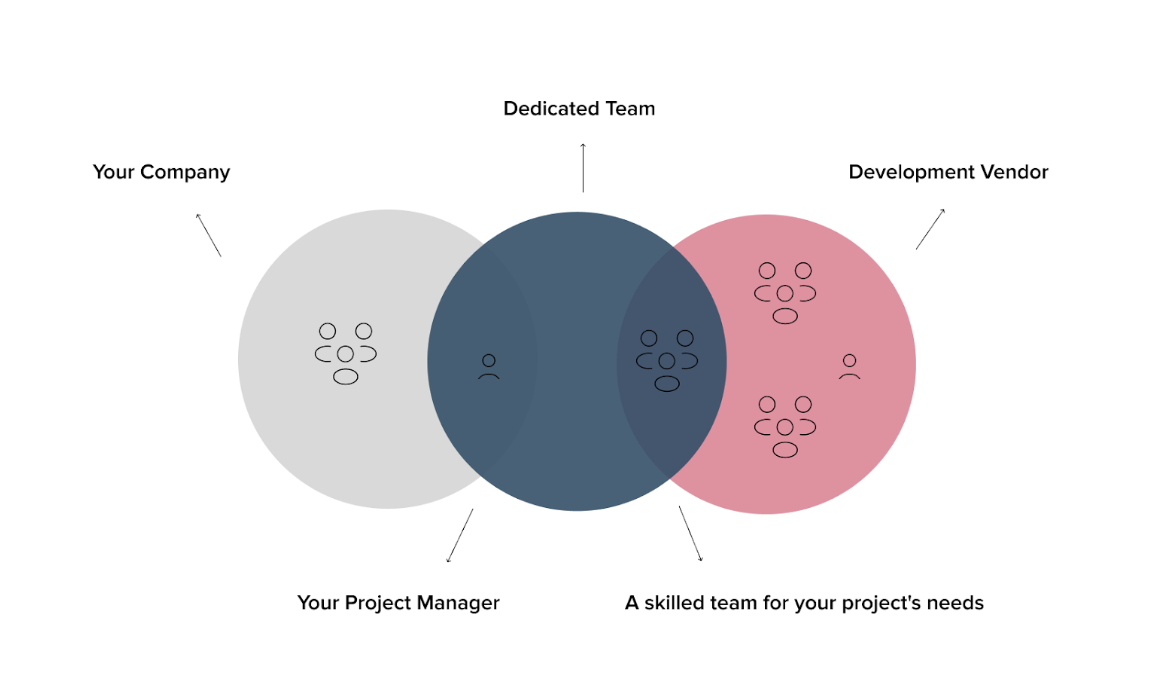
A visual to explain the position of a DDT (VT Labs)
When compared to an in-house staff, a dedicated team offers greater flexibility and cost-efficiency. Dedicated teams give you direct control over daily operations, priorities, and communication. This makes them ideal for long-term projects or ongoing development that requires continuous input and adaptation.
The dedicated development model also allows companies to collaborate with reliable service providers who handle recruitment, HR, and administrative tasks. This helps businesses save time while maintaining full transparency and control over the team’s output.
Below is an overview of how dedicated development teams differ from other models:
| Feature | In-house team | Project outsourcing | Dedicated development team |
|---|---|---|---|
| Flexibility | Limited, fixed team size | Low, changes depend on the vendor | High, can scale the team as per project needs |
| Cost | High (recruitment, salaries, overheads) | Moderate to high, depending on scope | Cost-efficient with predictable pricing |
| Control | Full internal control | Limited, managed by a vendor | Shared control with full project transparency |
| Engagement duration | Long-term only | Usually short-term or project-based | Long-term with ongoing collaboration |
| Focus on business requirements | Strong, but resource-limited | Varies by vendor’s priorities | Strong and dedicated to the client’s objectives |
Dedicated development teams combine the reliability of in-house staff with the cost advantages of outsourcing, offering businesses a balanced, scalable, and transparent solution for achieving their goals effectively.
Dedicated Team vs. Other Engagement Models
In software development, choosing the right engagement model is crucial for project success. There are three most common models, each of which fits different business needs, timelines, and budgets. Companies must understand these to make the right choice.
Here’s an explanation of each of these models.
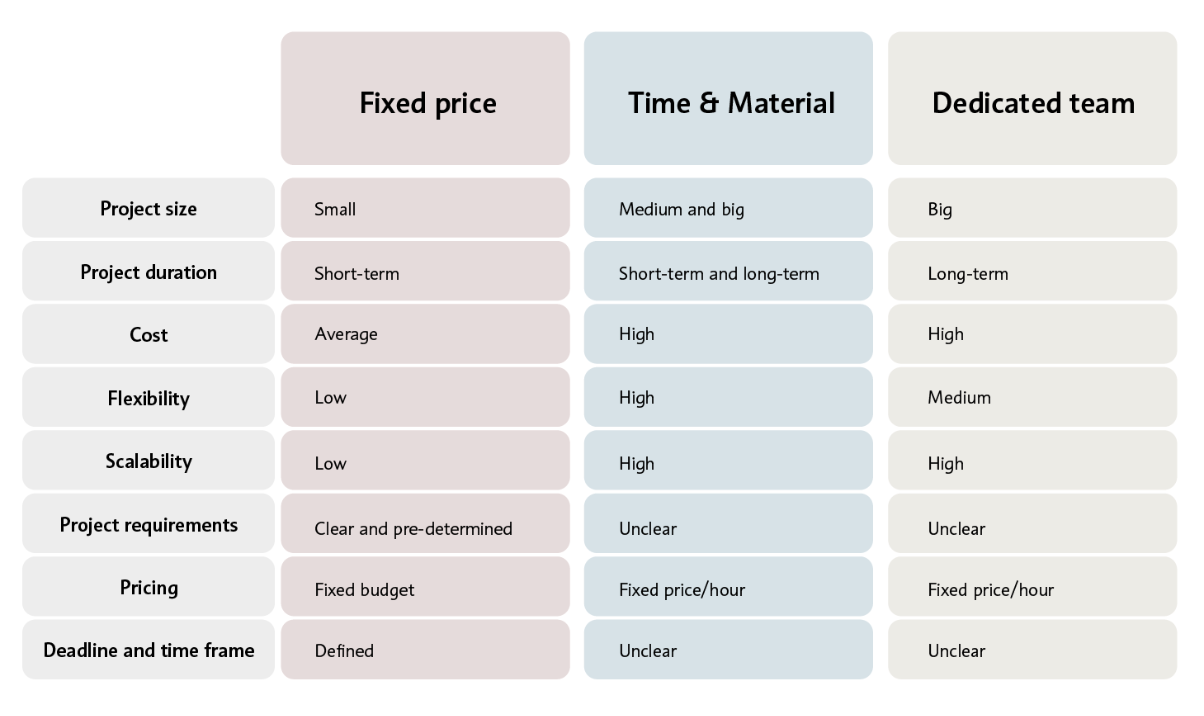
An overview of the engagement models (TIGO Solutions)
Fixed price model
The fixed price model works best for short-term projects with clearly defined goals, scope, and timelines. The budget is agreed upon before the project begins, and any changes in scope usually require a new agreement.
This model gives full cost predictability but less flexibility. Businesses often choose it for smaller projects or those that do not need continuous updates.
Time and materials model
In the time-and-materials model, companies pay based on the actual time and resources spent on development. This approach is ideal for projects requiring frequent changes, discovery phases, or uncertain requirements.
It allows for flexibility in adjusting priorities, adding new features, and improving quality standards as the project evolves. Since costs depend on ongoing work, budgeting must be managed carefully.
Dedicated development team model
A dedicated development team (or dedicated developers team) involves hiring a group of professionals who work exclusively on your project for an extended period. These dedicated developers become an integral part of your organization, sharing your vision, tools, and processes.
Unlike short-term outsourcing, dedicated teams offer long-term collaboration, deep understanding of the product, and strong alignment with your goals. This model suits projects requiring continuous development, maintenance, or innovation.
It enables easy scaling of the development team, allowing you to add or reduce members as the project’s growth or complexity dictates. Businesses often opt for a dedicated development team when they need to build complex software, explore new technologies, or maintain products with consistent quality standards over time.
While fixed-price and time-and-materials work well for shorter or more defined tasks, a dedicated development team is the best fit for long-term, evolving projects where flexibility, control, and collaboration truly matter.
When to Hire a Dedicated Development Team?
A dedicated development team is not the right choice for every business or project. It works best in specific scenarios where flexibility, technical expertise, and long-term collaboration are essential.
Dedicated teams deliver maximum value when projects require continuous growth, regular updates, and close alignment with business objectives. Below are some common cases where this model delivers the strongest results.
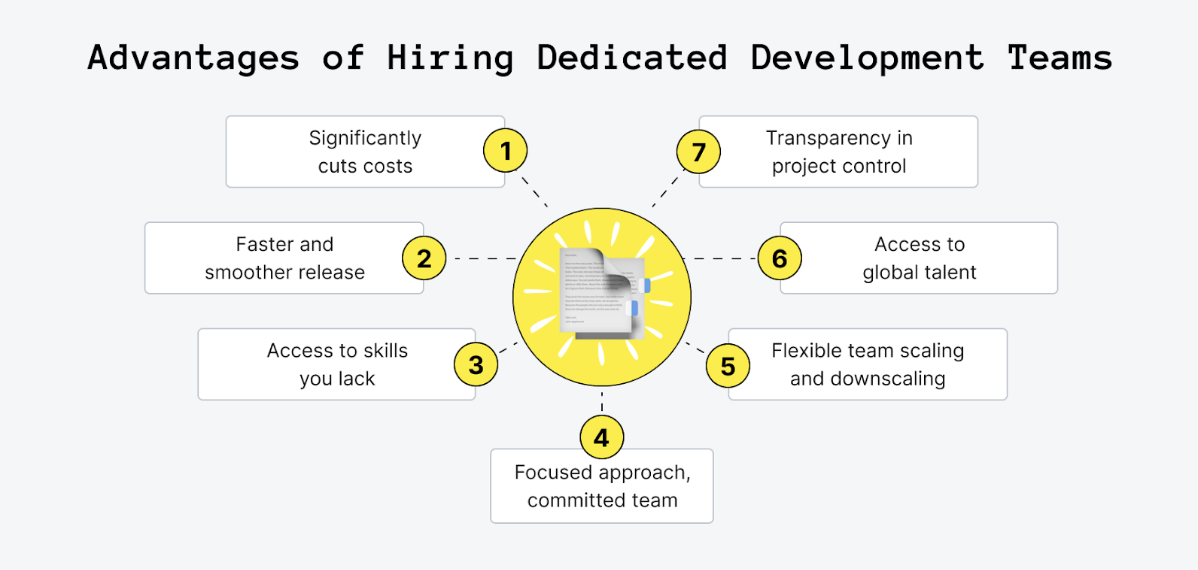
Advantages of hiring a DDT (Upsilon)
Startup building an MVP or scaling fast
For startups, time-to-market is everything. A dedicated development team helps founders quickly build and launch a Minimum Viable Product (MVP) without wasting months on hiring. These dedicated developers bring the right technical skills to design, code, and test efficiently while keeping costs predictable.
As the startup grows, the team can scale up to add new features, handle user feedback, and support faster product development. This makes it easier to test ideas and enter the market with speed and confidence.
Projects requiring continuous iterations or discovery
Some projects evolve and need regular changes or ongoing updates. In such real-time environments, dedicated teams are ideal because they work closely with the client to refine goals, add new features, and optimize performance.
With consistent project management and quality assurance, they ensure that the product remains reliable and up-to-date. This approach is ideal for SaaS platforms, mobile apps, or digital products that require ongoing innovation and maintenance.
Need for long-term support without expanding staff
Businesses that already have an internal IT team may still require assistance in maintaining and enhancing their products over the long term. Instead of hiring full-time staff, a dedicated development team offers a flexible and cost-effective way to handle ongoing updates, bug fixes, and performance improvements.
These developers act as an extension of the existing team, ensuring seamless collaboration without adding HR overhead or management complexity.
Exploring new technologies or market opportunities
When a company wants to explore new tools, technologies, or markets, hiring a dedicated development team is a smart move. These teams bring specialized skills that allow safe experimentation without disrupting existing workflows.
Whether it is testing AI-based solutions, adopting blockchain, or expanding into new digital markets, dedicated teams help businesses innovate in a controlled and cost-effective way.
Hence, a dedicated development team is the right choice for businesses aiming to scale, innovate, and maintain quality over time. Dedicated teams provide the flexibility, technical expertise, and reliability necessary to achieve lasting success.
How a Dedicated Development Team Is Structured?
The structure of a dedicated development team depends on the project’s goals, complexity, and size. While some projects require only a few core members, others may need a full-scale setup with multiple specialists.
Regardless of the scope, every team model includes essential roles that cover the entire development cycle, from planning and design to testing and deployment. Compared to an in-house team, dedicated teams provide the flexibility to scale up or down as needed.
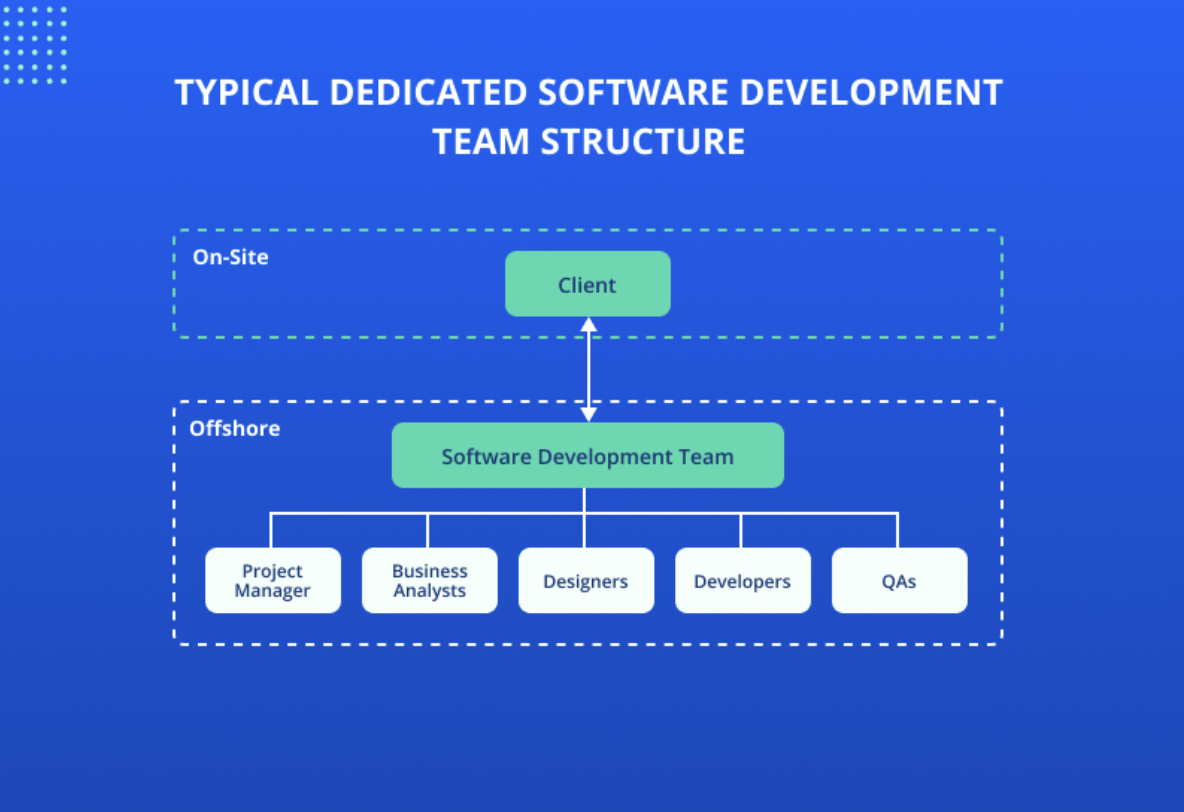
A typical DDT structure (JayDevs)
Core roles in a dedicated team
Every dedicated development team is built around a few key roles that ensure smooth communication, quality results, and timely delivery:
- Project manager: They oversee planning, communication, and coordination, ensuring the team stays aligned with business goals and deadlines.
- Developers: These dedicated developers are technical experts who write and maintain code. Their work shapes the product’s functionality, performance, and scalability.
- Quality assurance (QA) engineer: The QA engineer tests the software at each stage to ensure stability, usability, and adherence to requirements. Their focus on detail helps maintain high product quality.
- UI/UX designer: The designer creates user-friendly and visually appealing interfaces. They focus on enhancing the overall experience and ensuring the product is intuitive and engaging.
Together, these core roles make up the foundation of a dedicated development team, driving both technical and business success.
Additional specialists (when needed)
Depending on the project’s scope and phase, the team may also include additional experts:
- DevOps engineers: They are added when continuous integration, deployment, and system reliability are key priorities.
- Data engineers: They are involved when the project handles large amounts of data or requires complex analytics and reporting.
- Business analysts: They help bridge the gap between stakeholders and the development team by defining requirements and aligning features with business goals.
These specialists join the team model as needed to provide extra technical depth or strategic insights. Their involvement ensures that the dedicated development team remains efficient, adaptable, and ready to meet changing project demands.
Thus, dedicated teams are built to match each project’s unique needs. With a flexible structure and the right mix of roles, they deliver better results than a traditional in-house team.
Cost of Hiring a Dedicated Development Team
The cost of hiring a dedicated development team can vary depending on several key factors. These include team size, geographic location, the team’s skill level, and overall project complexity.
A small startup building a simple web application will have very different budget needs compared to an enterprise developing a complex AI-driven platform. Understanding these variables helps businesses plan their budgets wisely and maintain cost efficiency throughout the project.
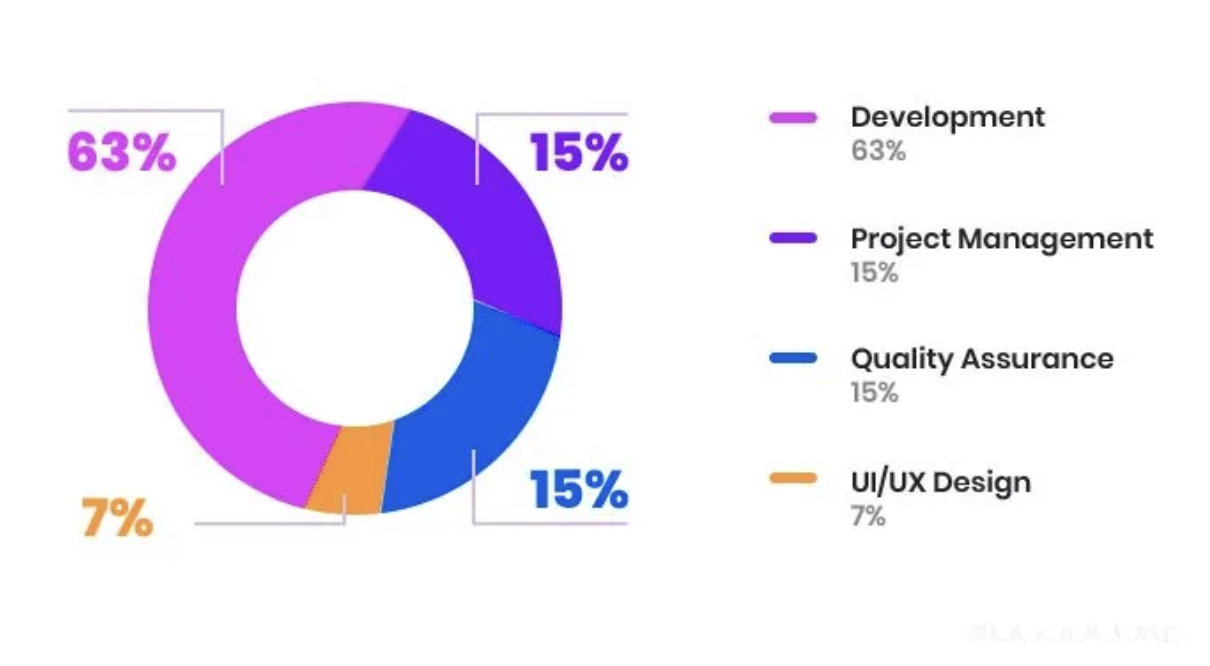
Example of cost distribution in DDT (GoodCore)
Main pricing factors
Team size
The more specialists your project requires, the higher the cost. A basic dedicated team typically includes a few developers and a project manager, while larger projects may require designers, QA engineers, and DevOps specialists.
Location
The location of dedicated development teams has a significant impact on pricing. For example, developers in Eastern Europe or South Asia often charge less than those in North America or Western Europe while maintaining the same level of quality.
Skill level
Senior developers or niche experts in specific technologies typically command higher salaries than mid-level or junior professionals.
Project complexity
Projects that demand complex architecture, advanced integrations, or emerging technologies generally require more time and expertise. This raises the total cost of hiring a dedicated team.
To estimate the total cost, businesses should begin by defining their project scope and identifying the required roles. Most dedicated teams offer flexible pricing models with monthly payments based on team composition or hourly rates depending on workload.
Clear communication, milestone-based billing, and regular performance reviews help control ongoing expenses and avoid unexpected costs.
Typical pricing ranges
While prices vary by region and expertise, here are some general benchmarks:
Eastern Europe: $35 to $60 per hour South Asia (e.g., India, Pakistan): $25 to $45 per hour Western Europe: $60 to $100 per hour North America: $80 to $150 per hour
A mid-sized dedicated team of 5 to 7 professionals might cost between $20,000 and $40,000 per month, depending on the mix of skills and project requirements. With clear planning and the right pricing strategy, companies can achieve high-quality software development without overspending.
How to Build and Manage a Dedicated Development Team?
Building and managing a dedicated development team requires more than just hiring skilled professionals; it also necessitates effective leadership and strategic planning. It depends on setting clear goals, fostering transparent communication, and building trust among team members.
A well-structured, dedicated team can become a long-term partner that drives product success, provided it is guided by clear direction and strong collaboration. Below is a step-by-step framework to help businesses create and lead an effective team for any project.
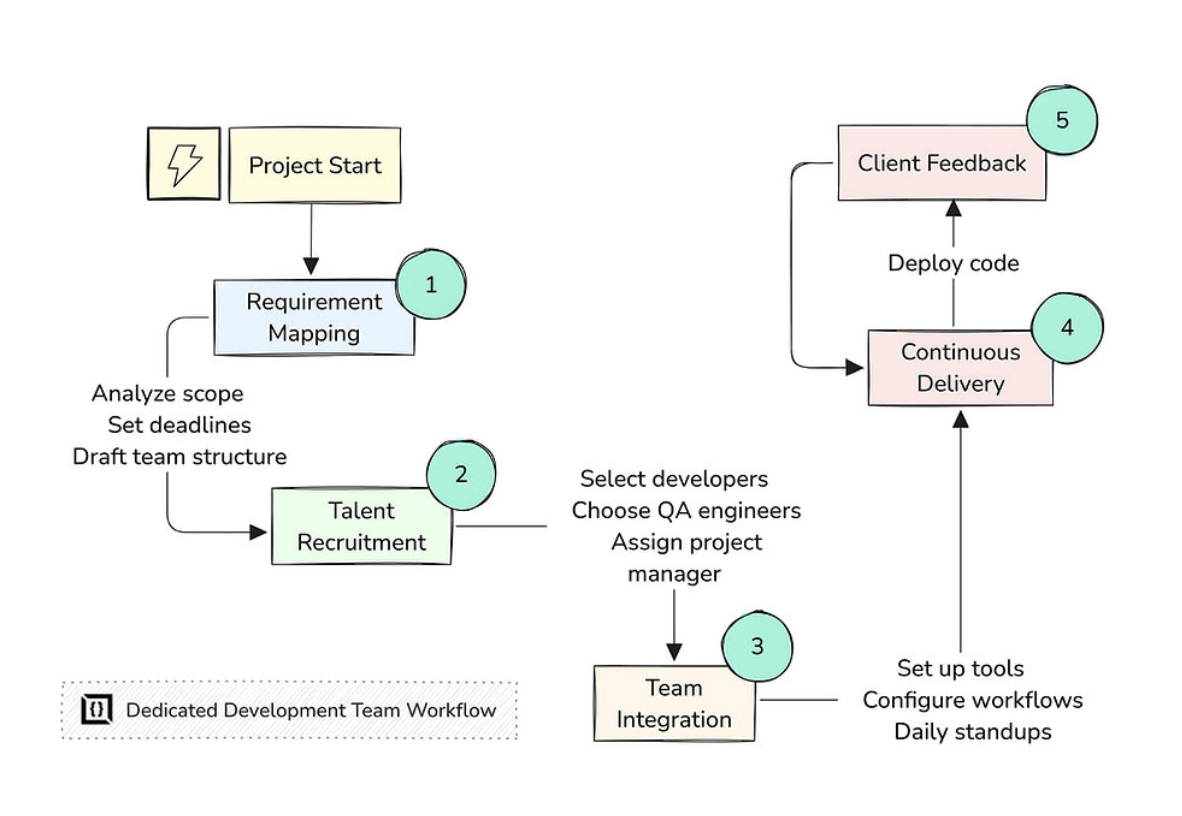
A typical DDT workflow (Leanware)
Step 1: Define business goals and ideal team size
Before hiring anyone, you must identify your business goals and what you want to achieve through the development process. This includes clarifying the project’s scope, desired outcomes, and timeline. Once the objectives are clear, determine the ideal team size and required roles.
For example, a small project may only require developers and a designer, while a complex solution might necessitate QA engineers, DevOps specialists, and business analysts. A clear vision ensures that you hire the right people from the start.
Step 2: Choose the right structure and roles
Every dedicated team should be built with balance in mind. You need both specialists who bring deep technical expertise and generalists who understand multiple areas of the project.
The right structure ensures flexibility, faster decision-making, and smoother collaboration. You must align the team setup with the complexity of your project and adjust roles as it evolves.
Step 3: Ensure all key functions are covered
A productive, dedicated development team includes all functions essential to the process. This typically covers:
- Analysis: Understanding business requirements and user needs.
- Design: Creating user-friendly and visually consistent interfaces.
- Development: Building the product and implementing core functionality.
- Quality Assurance (QA): Testing to ensure reliability and performance.
- DevOps: Managing deployments, automation, and system stability.
Covering these key functions helps maintain consistency, avoid bottlenecks, and ensure a smooth workflow across all members.
Step 4: Maintain clear communication and collaboration
Effective communication is the backbone of successful development teams. Utilize collaboration tools such as Slack, Jira, Trello, or Microsoft Teams to track progress and maintain transparency.
You can schedule regular check-ins or stand-up meetings to keep everyone aligned and on the same page. Since dedicated development teams often work remotely, cultural understanding and open feedback are crucial for building trust and maintaining motivation.
Hence, managing a dedicated team requires planning, structure, and ongoing engagement. By defining clear goals, ensuring all roles are covered, and promoting transparent collaboration, businesses can create teams that consistently deliver quality and innovation.
Case Study: Scaling Enterprise Software with a Dedicated Team
Saint-Gobain is one of the world’s oldest and largest manufacturing companies, operating across 70 countries. The company needed to modernize its IT Service Management (ITSM) system to support global operations efficiently.
Let’s review how the enterprise achieved its goal.
The challenge
Saint-Gobain’s IT department relied on two separate systems: Jira Software for software development and ServiceNow for IT service management. This dual setup caused inefficiencies, communication gaps, and high operational costs.
Managing tickets and projects across multiple platforms was problematic, resulting in slow response times and limited visibility. The company required a dedicated software solution that could unify development and IT workflows, enhance collaboration, and lower costs.
Team composition and process
To address this, Saint-Gobain partnered with Atlassian to form a dedicated development team to migrate and manage the new ITSM environment. The dedicated team included a project manager, system administrators, developers, and support engineers.
They transitioned 20,000 internal users from ServiceNow to Jira Service Management within a matter of weeks without requiring extensive training or disruption to daily operations. This enabled real-time visibility into projects and faster decision-making. Dashboards and shared data allowed both teams to manage incidents and change requests smoothly within a single ecosystem.
Results and impact
The outcomes of this dedicated software development team initiative included:
- 70% cost reduction within the first year of implementation
- 82% projected cost savings by the third year
- Faster deployment, completing the migration in just a few weeks
- Improved productivity and collaboration between IT and development
By leveraging a dedicated development team, Saint-Gobain successfully scaled its enterprise systems, achieving higher efficiency, greater transparency, and sustainable cost effectiveness across its global operations.
The company’s success highlights how a unified, agile approach to software development can dramatically enhance performance and reduce costs at scale.
Conclusion
Today, long-term collaboration with a dedicated development team can be a real game-changer. Companies can innovate more quickly, deliver high-quality solutions, and adapt rapidly to changing market needs.
A dedicated team ensures that knowledge stays within the project, processes improve over time, and productivity continues to grow with every iteration. The model's biggest advantages are its flexibility, deep expertise, and ability to scale sustainably. It provides the stability and skill set you need to achieve long-term success.
If you are planning your next project, consider partnering with a trusted web app development firm to hire a dedicated team tailored to your goals. Discover how this model can accelerate your project, enhance your operations, and bring your vision to life.
Nov 12, 2025
